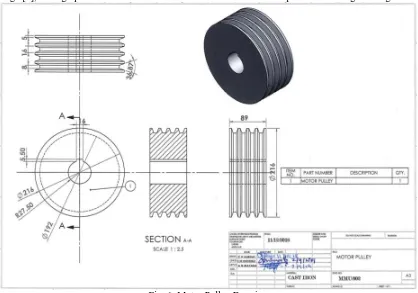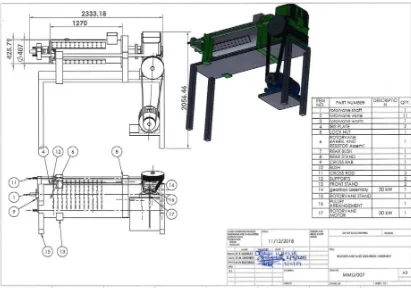Green Leaf Withering Maceration Cutting (CTC) Fermentation
Drying Bulking
Sorting Packaging
Dispatch
FABRICATION OF HIGH PRESSURE ROTORVANE FOR
QUALITY IN ORTHODOX TEA PROCESSING
Cosmas K. Langat1, Abel N. Mayaka2, Charles M. M. Ondieki3
1. INTRODUCTION
The conventional CTC black tea process involves withering finely plucked leaf from 78% moisture content to 70 ±2% moisture content (Coyle, 2006). The withered leaf is passed through a standard Rotorvane at a pressure of about 5MN/m2 (Coyle, 2006). The macerated leaf (ex-Rotorvane) is passed through an 8 - 10 tpi triplex CTC, fermented for 2 hours before drying and sorting into various grades (Coyle, 2006).
The black tea process flow chart is as shown below:
Fig. 1: Black Tea Manufacturing Process (Coyle, 2006).
Fig. 2: CTC process (Coyle, 2006)
1,2,3 Department of Mechanical and Mechatronics Engineering, Multimedia University of Kenya, Nairobi, Kenya
International Journal of Latest Trends in Engineering and Technology
Vol.(14)Issue(3), pp.019-025
DOI: http://dx.doi.org/10.21172/1.143.04
e-ISSN:2278-621X
Abstract - Orthodox processed tea refers to loose large whole particle tea leaf produced using traditional (or orthodox) methods of tea production, which involve plucking, withering, maceration/rolling, oxidation/fermentation and drying. Current orthodox tea technologies produce teas of very low quality but have large loose-leaf particle teas preferred by Orthodox tea consumers. Conventional black tea process includes CTC (Cutting, Tearing and Curling) which replaces the rolling stage in the Orthodox tea processing. The CTC tea manufacturing process produces high quality teas but is dusty making the tea undesirable to some consumers. From pilot plant laboratory trials, it was found out that the higher the Rotorvane pressure the higher the Orthodox made tea quality up to an optimum at 25 MN/m2, which gives the highest quality on Taste (T), Colour (C) and Mouthfeel (M) scores matching CTC made tea quality. Design of the high pressure Rotorvane [1] was done to determine minimum parameters required. This research paper is on fabrication of high pressure Rotorvane as per the design for quality improvement of large leaf teas. The fabrication is expected to produce Orthodox Large Particle Tea that looks and feels like orthodox large leaf tea but has the liquor characteristics, when infused and tasted, matching conventional CTC made tea quality.
Fig. 3a: Rotorvane Sketches
Fig. 3b: Rotorvane Sketches (Coyle, 2006)
CTC (cutting, tearing and curling), at the cutting stage, in conventional black tea process opens up catechins in plant cells in leaves that later oxidises in the fermentation stage thus producing high quality teas with good attribute of taste (flavour), hue/colour and mouthfeel when infused (Owuor et al., 1989). CTC teas are dusty making the tea undesirable to Orthodox tea consumers who prefer large whole leaf particle teas (Teacupsfull, 2018). However, current orthodox tea technologies produce teas of low quality because the process releases less catechins in plant cells during the rolling process.
The aim of this research paper is to fabricate a high pressure Rotorvane for Orthodox tea processing as per existing design [1] that will subject the withered leaf to a high pressure above conventional manufacturing pressure of 5 MN/m2 to rapture leave plant cells so as to release the catechins for the fermentation process. This will lead to elimination of CTC process and production of orthodox large particle teas that looks and feels like orthodox large leaf tea and has the liquor characteristics matching CTC tea quality when infused.
Plate 1: CTC and Orthodox tea images (Teacupsfull, 2018)
II. STATEMENT OF THE PROBLEM
Orthodox tea consumers prefer large whole leaf particle teas (Teacupsfull, 2018). However, current orthodox tea technologies produce teas of very low quality because the process releases less catechins in plant cells but have large loose-leaf particle teas preferred by Orthodox tea consumers. The CTC cutting process produces high quality teas when infused but are dusty making the tea undesirable to some consumers (Teacupsfull, 2018). The CTC process releases more catechins in plant cells which enables oxidation at fermentation, and brings about flavour, colour, brightness and mouthfeel in made tea quality. Therefore, a
Vane Iris Plates
Worm Screw
Hopper
3 8 1
3 . 5 12
70 3
8 1
Isosceles triangle h
process that produces black tea that looks and feels like orthodox large leaf tea but has the liquor characteristics matching CTC made tea quality is required. High pressure Rotorvane has been designed [1] and needs to be fabricated before commissioning it to check impact on quality of Orthodox made tea.
III. MATERIALS AND METHODS
3.1 Equipment and Experiments Set up
The fabrication and assembly were done in Unilever Tea Kenya Limited, Kerenga Engineering workshops in November and December 2018. High pressure Rotorvane parts and components required were determined as per the design [1]. The items were either fabricated / machined at Kerenga engineering Unilever workshop or sourced as per the approved design [1] from relevant suppliers. All the materials were sourced locally (within Unilever Engineering stores or bought locally within Kenya from importers of tea processing equipment and parts). Standard Rotorvane parts were re-used, where the design allowed.
The following Equipment and materials were be used in the fabrication and testing of the high pressure Rotorvane: • Standard 15” diameter Rotorvane parts, accepted into the design. These included:
o Standard gearbox pulley
o Gearbox pulleys
o Keys and keyways
o Rotorvane shaft
o Shaft flanges
• Purchased high pressure Rotorvane parts. These included:
o 30 kW motor
o 30kW gearbox
o Brass iris plates
o Rotorvane motor pulley.
o 4 pieces of B118 rubber 'V' belts. • Pressure (stress) sensor
• Lathe machine
• Chain block and overhead crane • Drilling machine
• Shaping machine • Grinder
• Milling machine • Welding machine. • Transport Vehicle
The designed high pressure Rotorvane was assembled as per the design parameters obtained [1] and tested dry, ready for commissioning with green leaf.
3.2 Design Parameters
The following were minimum design parameters for high pressure Rotorvane [1].
Table 1: High Pressure Rotorvane Design Parameters [1]
Part Material Standard
Rotorvane (Rv)
High Pressure Rotorvane Requirements
Recommendation / Remarks
Power 15 hp (11
kW)
40 hp (30 kW) Purchase 30 kW motor
Gearbox Cast Iron 15 hp (11 kW)
40 hp (30 kW) Purchase 30 kW gearbox
Barrel (wall) thickness Cast Iron 13 mm 12 mm Standard RV barrel to be used Iris plate thickness Brass 15 mm 19 mm New iris plates to be fabricated Motor Pulley diameter Cast Iron 152 mm 216 mm New motor pulley to be fabricated Gearbox pulley
diameter
Cast Iron 398 mm 398 mm Standard gearbox pulley to be used
Number of 'V' belts High tensile Rubber
4 4 No change in number of 'V' belts
Part Material Standard Rotorvane (Rv)
High Pressure Rotorvane Requirements
Recommendation / Remarks
Length of the pulley 'V' belts
High tensile Rubber
B102 B118 New 'V' belts to be bought.
Maximum belt tensions 672 N 492 N Standard 'V' Belts to be used
Motor Keyway 89 mm 19 mm RV motor keyway is sufficient
Motor pulley Keyway 89 mm 19 mm RV motor pulley keyway is sufficient
Motor pulley key Mild Steel 90 mm 19 mm 40 hp (30 kW) RV motor key is sufficient
Gearbox pulley keyway
89 mm 30 mm Gearbox pulley keyway is sufficient.
Gearbox pulley key Mild Steel 90 mm 30 mm Gearbox pulley key is sufficient. Rotorvane Shaft
diameter
EN24 Steel 63.5mm 63.3mm No change in Rotorvane shaft size.
Flange bolt diameter High Tensile Steel
20mm 15mm No change in flange bolt sizes.
Bushes Phosphor
Bronze
50 & 63.5mm
40mm No change in bush sizes.
4. RESULTS AND DISCUSSIONS
Drawings
The fabrications were carried out as per design drawings as follows:
Based on design [1], the high pressure Rotorvane was fabricated and assembled as per the following drawings:
Fig. 7: Pulley Arrangement Drawing
Fig. 9: Rotorvane Assembly complete with gearbox and motor.
Plate 4.1: Iris Plates
Plate 3: Motor, Pulleys, V-Belts
The parts were fabricated and assembled to high pressure Rotorvane as per the table of parameters, existing parts and parts purchased / machined as per design drawings for the required components. The assembled high pressure Rotorvane was tested dry to confirm functionality.
5. CONCLUSION AND RECOMMENDATION
It is possible to fabricate and assemble a High-Pressure Factory Rotorvane based on design calculations and analysis giving required minimum parameters, by modifying or upgrading some components of a standard Rotorvane, ready for testing for impact on orthodox made tea quality. There is need to test the fabricated high pressure Rotorvane for Orthodox tea processing to check impact on quality of orthodox teas and possible commercial opportunity.
6. REFERENCES
[1] Coyle, J. (2006). CTC, Orthodox Rollers and Rotorvane Layouts and Diagrams. Retrieved from http://janicecoyle.weebly.com/udhagamandalam-india.html
[2] Owuor, P. O., Othieno, C. O., & Tadakazu, T. (1989). Effects of Maceration Method on the Chemical Composition and Quality of Clonal Black Teas. ResearchGate.
[3] Teacupsfull. (2018). The difference between CTC and Orthodox Tea. Retrieved from https://www.teacupsfull.com/blogs/blog/the-difference-between-ctc-and-orthodox-tea


![Table 1: High Pressure Rotorvane Design Parameters [1] Part](https://thumb-us.123doks.com/thumbv2/123dok_us/1409285.1653501/3.612.69.563.531.717/table-high-pressure-rotorvane-design-parameters.webp)


